Recent reports show that it’s a harsh reality of the construction labor market that 83% of contractors have difficulties hiring workers.
When you also factor in an increased demand for housing, health care, and infrastructure projects, the stress of finding construction workers becomes almost unbearable.
But a small fraction of contractors (8%) says they have no difficulties hiring new people. Now, either they’re lying, or they have found a way to combat these challenges.
So, let’s explore the top HR challenges the vast majority are struggling with, but a minority have managed to solve.
In this article...
Workforce Planning
Construction is a very project-by-project-oriented industry. This means that companies are more focused on securing the next job than considering the workforce needed for the project.
So, in most cases, they scramble to find adequately skilled workers and fill the gaps needed to complete the project successfully.
Obviously, the workers won’t just magically appear when you need them, and labor shortages can become a severe problem.
Therefore, HR managers need to work closely with other construction professionals (i.e., architects, contractors, and project managers) to determine workforce requirements for each project they undertake on time.

If the HR staff need to find specifically skilled workers that are in high demand, it’d be easier if they had more time to do so.
Then they would be able to reach out to more hiring agencies, post job ads on more job boards, or even have a more comprehensive hiring system that can include attending job fairs, industry events, and school presentations.
These practices fall under what we call workforce planning. Essentially, the HR department needs to strategically think about hiring the right skilled people for the right job at the right time.
They must consider the company’s future labor requirements and address shortages due to retirement, promotions, or gaps between projects.
So what constitutes good workforce planning? In a nutshell, it has to be:
Strategic | Workforce planning should be a part of a larger and long-term business planning that will minimize the potential impact on all current projects. |
Dynamic | Changes in the industry should reflect the speed and quality of hiring. Planning on time can address sudden changes and adjust plans. |
Progressive | Using project data and taking into account workforce demographics and labor availability ahead of time. |
Purposeful | Effective workforce planning should determine if you can afford to have full-time employees or if you’ll have to rely on hiring independent workers and subcontractors. |
Even though you want to bid for more projects for your company so you can keep your workers busy, it’s important to pay equal attention to workforce planning as you would to securing more jobs.
In the end, effective workforce planning isn’t just about filling the gaps in your construction team.
It also brings other benefits, such as maximizing project efficiency and avoiding under-allocation.
But most importantly, projects are finished with increased quality, bringing in more profits.
Diverse Workforce Needs
The construction industry is unique in terms of its diverse workforce.
On a single project, there can be a large mix of people consisting of independent contractors, union workers, full-time office staff, or temporary field workers.
Not to mention occasional family members or friends chipping in to finish on time.
Such a fragmented workforce needs a holistic approach to address their concerns and needs to keep them employed for a long time.
HR’s mission in this regard means clearly outlining their roles and responsibilities and accurately categorizing each worker.
Obviously, wages will have to be adjusted based on experience, union or non-union membership, but also type of position.

But another problem requires more flexibility in HR’s hiring practices. More and more workers are coming from different countries.
Addressing cultural barriers and language knowledge is instrumental in keeping construction sites productive, safe, and open-minded workplaces.
For example, the latest CITB research identified that 13.4% of the total construction workforce in the UK were EU nationals, with almost 50% of them residing in London.
Yet, addressing labor shortages by importing workers is not an easy task.
This is especially true in countries like the UK, where post-Brexit government mandates and regulations hinder the entry of low-skilled workers outside of the UK.
As you can see in this graph, the number of non-UK construction workers is falling significantly.

Another way construction companies can recruit more people is by hiring more women.
Now, even though women made up 47% of the total workforce in the US in 2021, only 11% of them worked in construction.

Hiring women is a commendable practice, but it also comes with its own challenges, mainly in terms of tackling outdated prejudices and the industry’s prevalent “macho culture”.
So, it’s not surprising that many women report sexual harassment and discriminatory behavior from other (male) coworkers.
Hostile workplaces keep more women out of the industry, even though they’re just as qualified and experienced as their male counterparts.
Therefore, HR must address their concerns and create a more empathetic and positive working environment.
All in all, focusing on diversity ensures there’s a wide pool of eligible candidates to fill the labor gaps, but managing their needs and interests comes with its own set of challenges.
Safety Regulations
Injuries and accidents are far too common on construction sites, so HR must be diligent in informing the staff about safety protocols and making sure they understand all OSHA safety requirements.
This doesn’t just protect the workers but the company as well.
Think about the lost productivity, schedule delays, higher insurance premiums, medical expenses, and costs of hiring replacements for the injured workers.
Therefore, having a safe working environment always has a positive effect on the company’s bottom line.

But sometimes, ensuring safety can be difficult, which was evident in the height of the COVID-19 pandemic.
After the US government imposed mandates for safe workplaces, especially regarding vaccination, the industry stepped back.
Namely, the workers’ vaccination rates were low compared to other industries, which posed many problems to completing projects on time and following federal regulations.
When you also factor in the resolute decision of many workers that they’d rather quit than get vaccinated, there isn’t much construction companies can do to ensure business continuity.
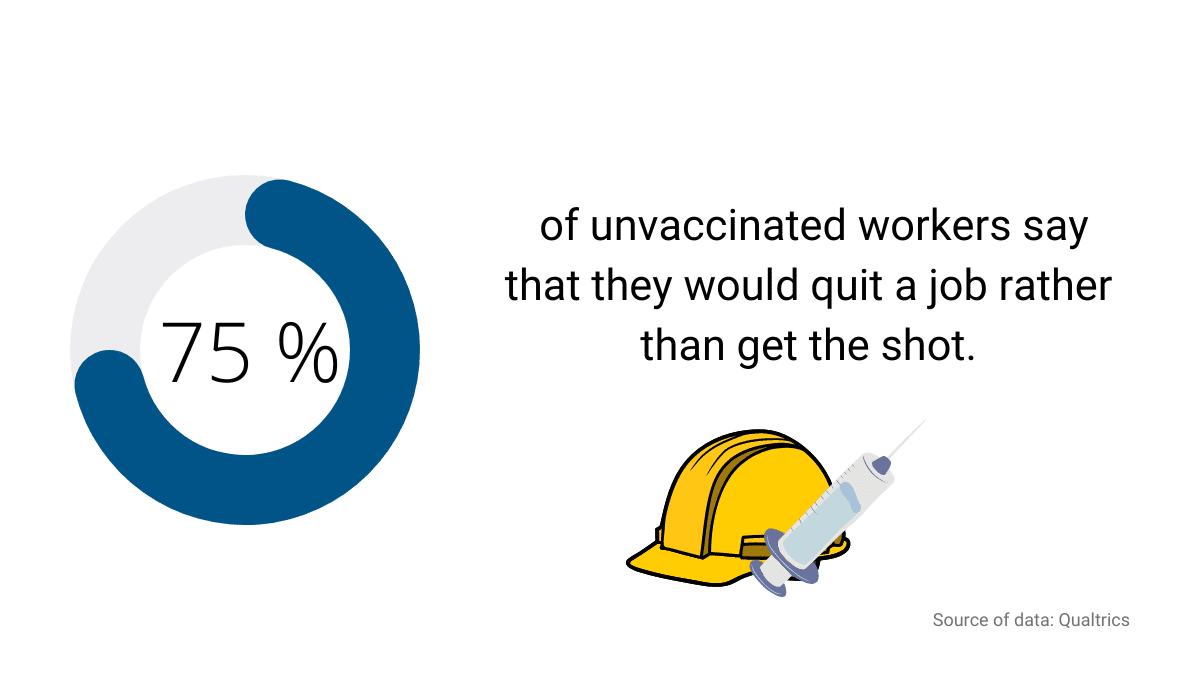
Yet, there are some solutions the HR department can implement. First, regular testing can allow some breathing room and help companies avoid OSHA fines.
Then, there’s also a recommendation from Alexandra McManus, the co-founder and CEO of Eyrus.
She says that workers can carry wearable technology that will allow supervisors to track their location and ensure they keep a safe distance from each other on the construction site.
All in all, the HR department should do everything in its power to create a safe workplace for everyone, from safety training to implementing necessary safety protocols every worker can follow.
Employee Retention
Keeping good workers is just as important as hiring them.
Any good worker knows their worth, and they’re not going to put up with unsafe working conditions, low pay, and terrible supervisors.
They know they’re skilled enough so they won’t have a problem finding another job.
Construction workers quit for a variety of reasons.
Some construction companies report that their workers changed jobs for an extra £2-3 an hour.
At the same time, others value better benefits, better hours, and work-life balance, like this construction worker on Reddit.

The bottom line is that most construction companies don’t have employee retention processes and strategies to ensure their workers are happy and motivated.
While you can’t retain everyone, comprehensive rewards and recognition programs can help keep a substantial number of workers.
Not to mention that training and promotions signify that a company cares about their employees’ career progression and doesn’t treat them as just another pair of hands.
Rewarding quality workers can show others that hard work and dedication pay off.
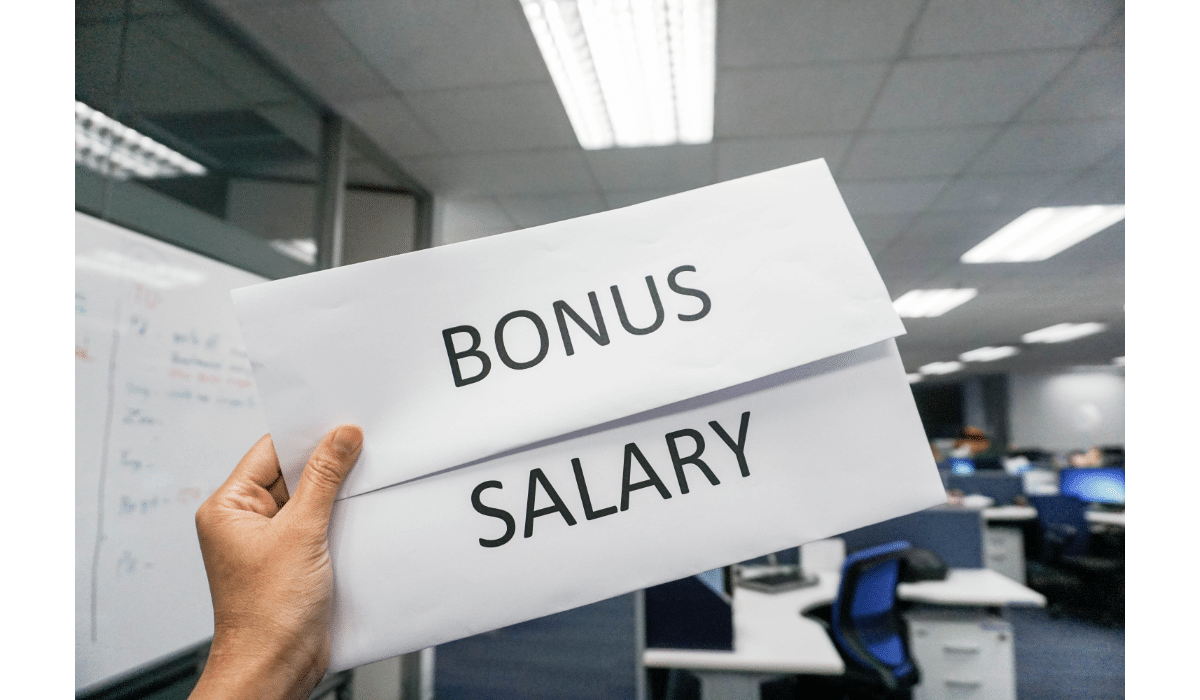
So how is HR tackling the retention problem?
Most commonly, they increased the base pay rates, provided incentives and bonuses, and improved their benefits package.
While money is essential to keeping workers happy, it isn’t the only solution.
If you ask construction workers, one of their biggest problems is having an unsupportive or even downright abusive supervisor.

Not everyone is fit to lead a team, so when considering people for a managing role such as superintendent or general foreman, carefully analyze their qualifications and soft skills that will enable a positive working environment.
Having a good leader means improved communication which is key to a collaborative and supportive workforce.
If people trust each other and the person in charge, they’d be more willing to contribute positively to the project and maintain the highest standard of operation.
Even just allowing employees to voice their opinions and concerns is a great step in improving the team’s morale and making them feel they matter.
In the end, a great salary is just the first step in any company’s employee retention strategy. Still, HR’s responsibility is to offer additional incentives for job fulfillment and high performance.
Strong Competition
According to the latest research conducted by Institute for Public Policy Research, almost 750 000 construction workers in the UK could retire in the next fifteen years.
But the problem is that there aren’t enough people to replace them.
Inevitably, this creates strong competition for the remaining workers and greater negotiation power for the traders.
Skilled workers were always in high demand, but these days it seems they’re more valuable than gold.
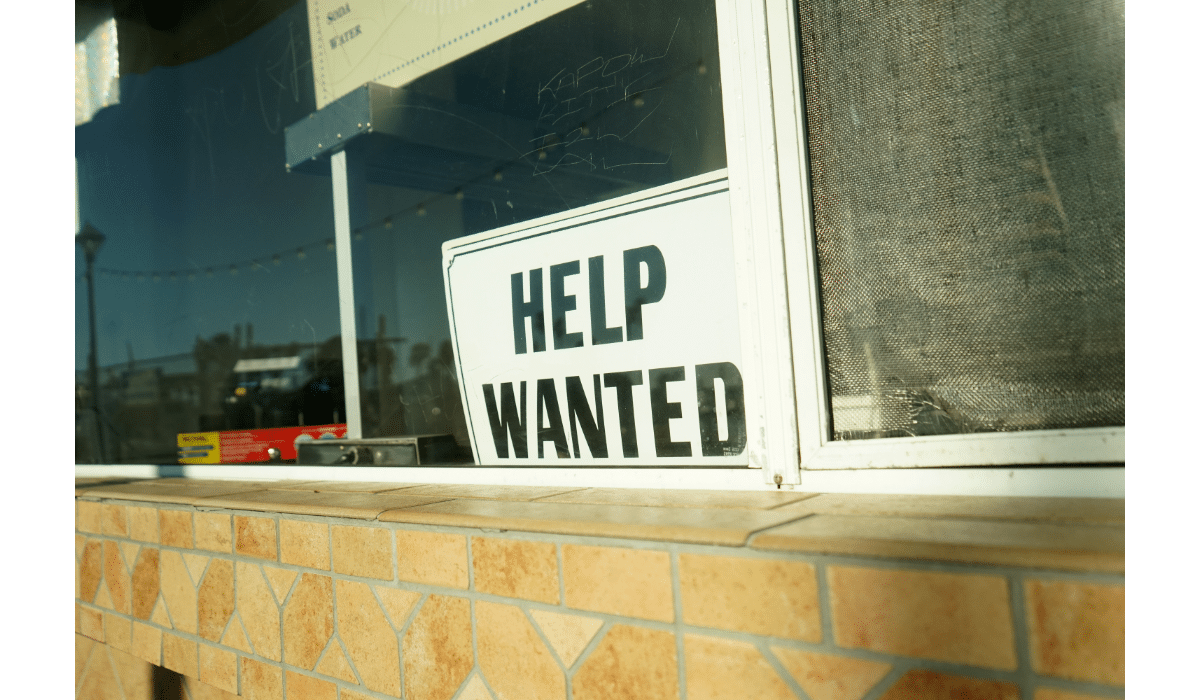
So, if you want to attract quality construction workers and convince them you’re the one they should work for, you need to stand out.
Since workers can essentially pick and choose employers at this point, they need a good reason to put your company as their first choice.
There are different ways you can beat your competition. First, think about the profile of the new hires entering the job market.
You’re most likely looking at Millenials and Gen Z-ers, who approach work in a different way from the older generations.

They value mentorship and on-the-job training, which provides them with fast promotions and career growth.
They also value knowledge and continuous learning, so it’s beneficial to implement regular mentor and training programs in your company.
In addition, young people tend to be more socially and environmentally conscious, so the company must have strong initiatives to promote positive social change, from prioritizing diversity to being environmentally conscious.
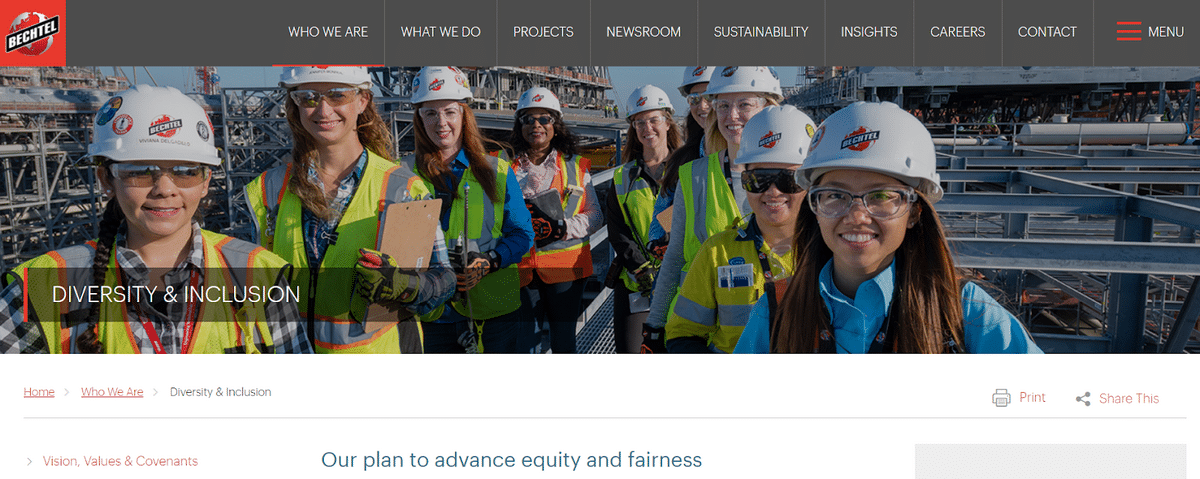
Finally, consider implementing technology as your selling point to prospective candidates. Christopher Griffin, President, and CEO of USG Corporation, believes that the construction industry can benefit greatly from construction technology:
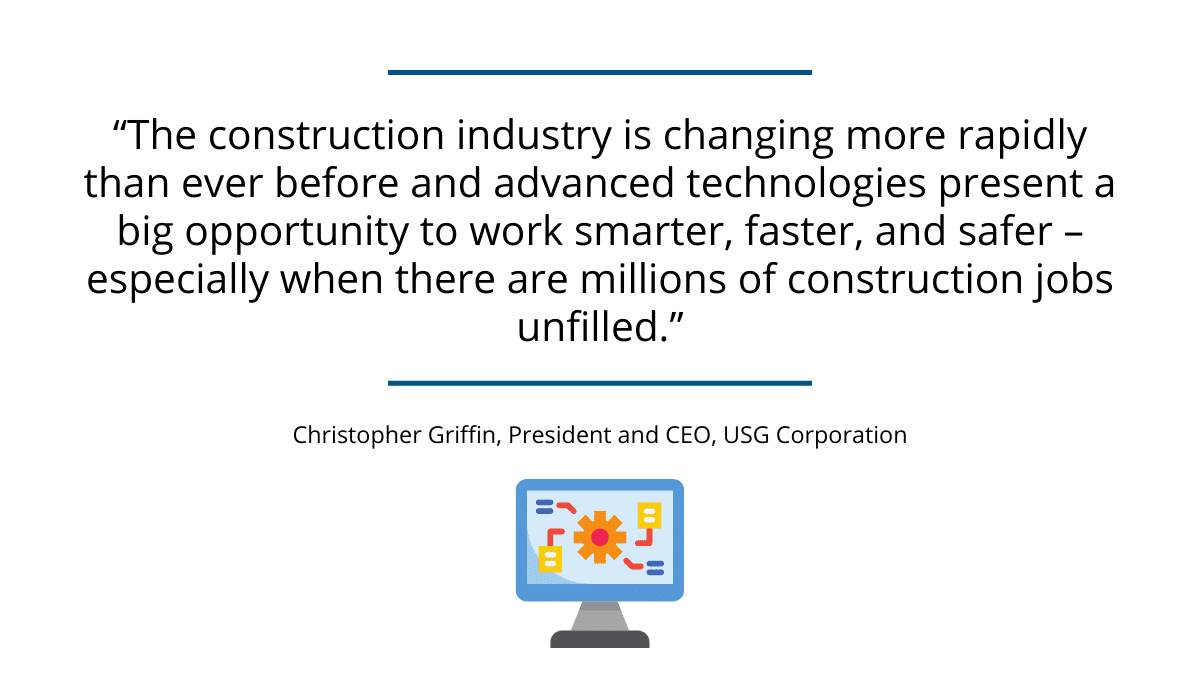
This is an attractive incentive for workers who want to be at the forefront of industry changes and work better than before.
So, it’s not surprising that more and more construction companies are looking into construction software and mobile apps to improve their operations and remain competitive in the industry.
But keep in mind that once you implement all these incentives to attract quality workers, you have to maintain them.
If they’re only used as a marketing tool, the workers will leave you because they’ll realize the company doesn’t prioritize its impact on society and doesn’t want to make positive changes.
Conclusion
Labor shortages are a reality all industries have to live with.
But these shortages also pose great opportunities for construction companies to improve their existing processes and rethink how they attract potential new workers.
How are you standing out from your competition? Do you have a strategic hiring plan? Do you have adequate safety protocols to maximize worker safety?
Answering these questions will help construction workers consider working for you long-term.
Remember that a construction company is only as good as the quality of its workers, so it’s in your best interest to find good workers, even in these challenging times.





